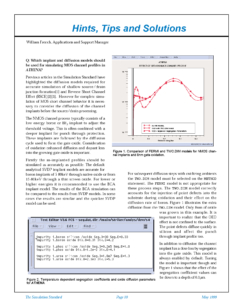Hints, Tips and Solutions
Q: Which implant and diffusion models should be used for simulating MOS channel profiles in ATHENA?
A. Previous articles in the Simulation Standard have highlighted the diffusion models required for accurate simulation of shallow source/drain junction formation[1] and Reverse Short Channel Effect (RSCE)[2][3]. However for complete simulation of MOS short channel behavior it is necessary to consider the diffusion of the channel implants before the source/drain processing.
The NMOS channel process typically consists of a low energy boron or BF2 implant to adjust the threshold voltage. This is often combined with a deeper implant for punch through protection. These implants are followed by the diffusion cycle used to form the gate oxide. Consideration of oxidation enhanced diffusion and dopant loss into the growing gate oxide is important.
Firstly the as-implanted profiles should be simulated as accurately as possible. The default analytical SVDP implant models are accurate for boron implants of 5-80keV through native oxide or from 15-80keV through a thin screen oxide. For lower or higher energies it is recommended to use the BCA implant model. The results of the BCA simulation can be compared to the results from SVDP models. In some cases the results are similar and the quicker SVDP model can be used.



